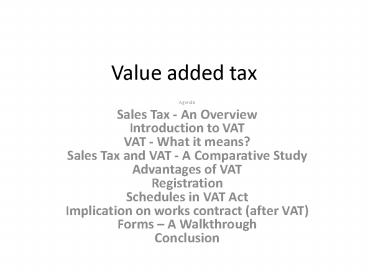Value added tax PowerPoint PPT Presentation
1 / 20
Title: Value added tax
1
Value added tax
- Agenda
- Sales Tax - An OverviewIntroduction to VATVAT -
What it means?Sales Tax and VAT - A Comparative
StudyAdvantages of VATRegistrationSchedules in
VAT ActImplication on works contract (after
VAT)Forms A WalkthroughConclusion
2
Why VAT?
- To have uniform rate of tax throughout the
- country
- To abolish deferral/waiver/incentivesTo abolish
internal check postsTo facilitate self
assessmentTo reorganize commercial tax
departments and enable computerization
3
VAT Implementation
- Year 2005 22 states implementedYear 2006 6
states have implementedYear 2007Remaining
states have implemented - Status in Tamil Nadu
- July 22, 2006 Finance Minister of Tamil
- Nadu announced in the state assembly
- about the introduction of VAT system
- October 28, 2006 VAT Act was published in
gazette from 1/1/2007
4
What is VAT?
- VAT is a multi-point tax collected at every stage
- VAT is arrived at by deducing the tax paid on
purchases from the tax payable on sales
5
Example
- input purchased rs.1,00,000
- tax paid 4
rs.4,000 - Output sold within a month rs. 2,00,000
- Output tax to be collected 12.5 25,000
- VAT Payable after setting off input tax
21,000(25000-4000)
6
Concept of VAT
- Essence of VAT is providing set-off for the tax
paid earlier, given effect through the concept of
input tax credit/rebate - VAT is based on the value addition to the goods,
and the related VAT liability of the dealer is
calculated by deducting input tax credit from tax
collected on sales during the payment period
(say, a month).
7
CONCEPT OF VAT Example
- A - RAW MATERIAL PRODUCER
- Sales ValueRs .100/-
- Gross VAT _at_ 10Rs. 10/ -
- Net VATRs .10/
- B -
MANUFACTURERSales ValueRs .140/-Gross VAT _at_
10Rs. 14/ - - Net VAT Rs.14 Rs. 10 Rs. 4/-
- C -
WHOLESALERSales ValueRs .170/-Gross VAT _at_
10Rs. 17/ -Net VAT Rs.17 Rs. 14 Rs. 3/- - D -
RETAILERSale Value Rs. Sale Value
Rs.190/-Gross VAT _at_ 10 Rs.19/-Net VAT Rs.19
Rs. 17 Rs. 2/
8
Advantages
- Rationalized Tax Structure 1 , 4, and 12.5
- Simple Minimum exemptions with lesser rate and
refund - procedures.
- Transparent Being a consumption tax, more
transparency - is maintained
- Bigger Opportunities By giving tax credits, the
- manufacturing cost will be less and even bigger
enterprises - will establish their presence in Tamil Nadu.
- Reduced Prices of Goods Elimination of tax
cascading - and pyramiding effects
- Growth Creates more job opportunities in the
state. - tax Compliance Checks tax evasion
9
Schedules
- VATable Goods)Part A - Bullion, Gold, Silver
(taxable _at_ 1)Part B - Taxable _at_ 4 (150
items)Part C Taxable _at_ 12.5 (69 items)
W.E.F 12.07.2007 - Non-VATable (12 items
- Compounding Schemes for Hotels, Restaurants
Sweet Stall - Exempted Goods (Section 15
- zero Rate Sale International Organization
10
Compounding Scheme
- Applicable to Assesses, who effect second or
subsequent sales, pay 0.5Tax as a percentage on
Gross Turnover.Such dealer cannot collect tax
from thecustomers. - Limit Rs. 50 Lakhs Per Annum
- VAT invoice cannot be issued
11
Implication on works contract
- Section 5 provides for levy of tax on
- transfer of property in the goods involvedin the
execution of works contract.Rule8 (5) prescribes
methods of computing. - ?ITC is permissible in this Section on
- goods mentioned in the first schedulepurchased
within the State and used inthe execution of
works contract.
12
registration
- Dealers having a turnover of 10,00,000 during any
three months or having a turnover of 40,00,000
per annum should register as vat dealers - Others should register as Turnover TAX dealers
13
ToT dealers
- Dealers paying under this scheme are not entitled
for ITC and cannot collect tax from customers - Exempt vis-à-vis Zero Rated
- Dealer not entitled for input tax credit if the
sales are not taxable and exempted - Refund on input tax applicable to a dealer who
pays no tax on his output eg exports
14
VAT Stock Transfer
- Due to existence of CST Act, stock
transfers/consignment sales are exempted as at
present - When stock transfers are exempted, ITC is
eligible in excess of 3 for rebate on the goods
used to produce products
15
Treatment of Exports Deemed Exports
- Export will be zero-rated. Refund on ITC
- Penultimate sale is also treated as Export and
eligible for ITC - Sales to SEZs and International Organizations are
zero-rated ITC available for both contractors as
well as sub-contractors - Refund of ITC to Exporters/Deemed Exporters
- will be made within 180 days from the date of
claim. Beyond which period such credit lapse to
Government.
16
Capital Goods
- ITC eligible for purchase of capital goods
- used for the manufacture of taxable goods
- Eligibility From the date of commencement of
commercial production - 50 can be adjusted in the first year,
- balance 50 in the second and third year
- Remaining unadjusted amount, if any will lapse
17
Returns
- Every Dealer should file monthly return in Form I
disclosing the input tax paidand output tax
payable by 20th of thefollowing month - Details of TIN should be furnished on both
purchase and sales - Separate Forms J, K, L, M are meant for various
categories of dealers
18
Input tax Credit
- Section 19 and Rule 10 are relevant for
- ITC claim.
- ITC is available in respect of tax paid goods
i.e. vatable goods. (4 12.5
19
Accounting
- Yarn purchased for 2,00,000 at 4 vat
- Purchase a/c dr 2,00,000
- Vat a/c dr 8000
- To vendor a/c 2,08,000
20
sales
- Then he sold them after converting into cloth
- At 12.5 for 3,37,500
- Distributor a/c 337500
- To Vat a/c 37500
- To sales 3,00,000

